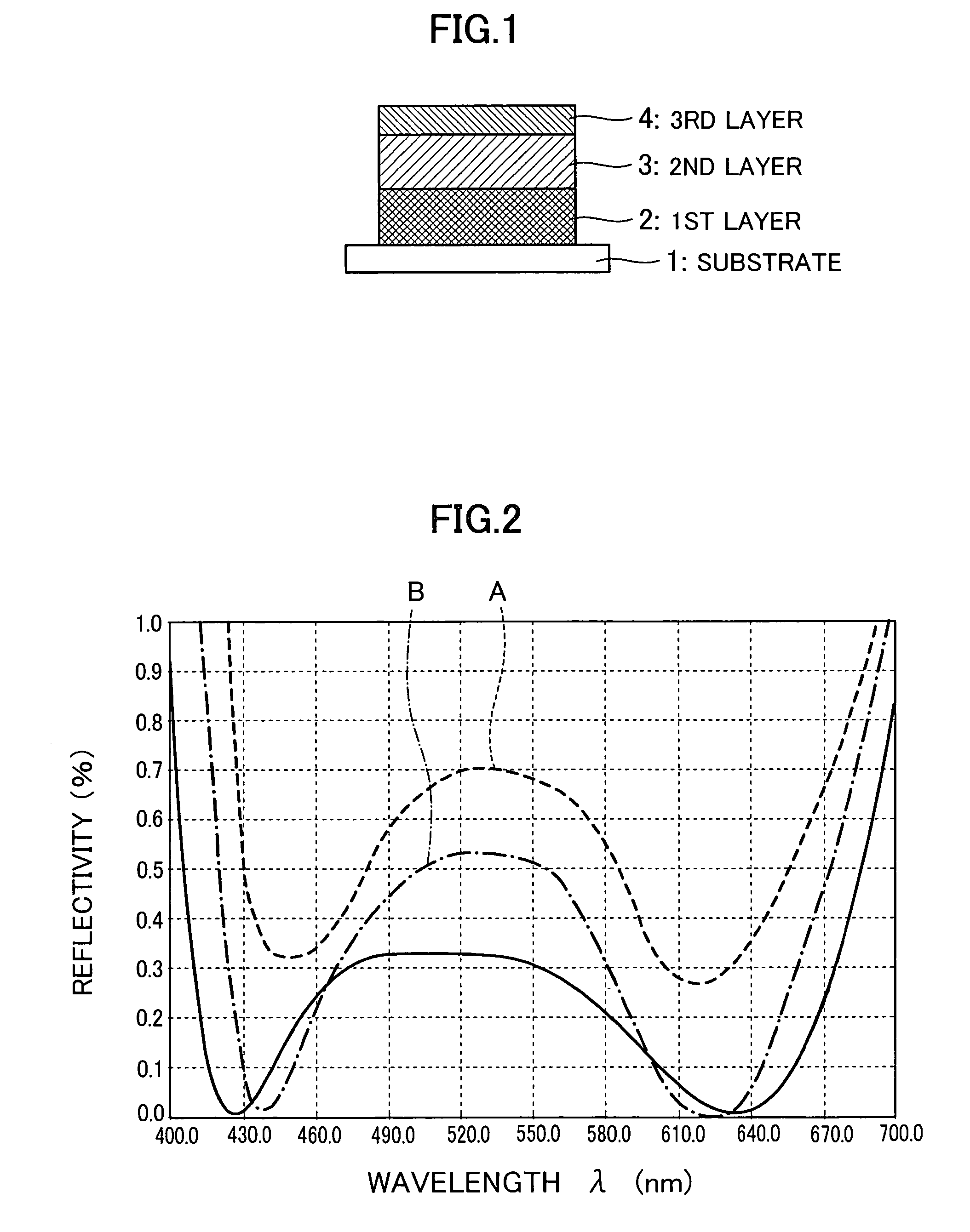Anti-reflection film
a technology of anti-reflection film and film body, which is applied in the direction of instruments, coatings, optics, etc., can solve the problems of increased manufacturing cost, insufficient anti-reflection effect within the visible band, so as to reduce reflectivity, enhance anti-reflection performance, and reflect poor
- Summary
- Abstract
- Description
- Claims
- Application Information
AI Technical Summary
Benefits of technology
Problems solved by technology
Method used
Image
Examples
embodiment 1
[0058]An exemplary anti-reflection film according to the present invention is 1.90 in substrate refractive index and 510 nm in spectrometric wavelength λ, as detailed in the table below:
[0059]
TABLE 1RefractiveSpectrometricLayer #IndexwavelengthMaterialsSubstrate1.901st Layer1.760.50 λMixtures of Y2O3, La2O3, andAl2O3,or Mixtures of ZrO2 and SiO22nd2.300.50 λNb2O5 or TiO2Layer3rd Layer1.460.25 λSiO2Air1.00
[0060]FIG. 2 shows a reflectivity of the first embodiment of the anti-reflection film in the event of an incident angle of light beam ranging from 0 to 10 degrees. As will be recognized from solid characteristic curves of the reflectivity in FIG. 2, the anti-reflection film effectively reduces the reflectivity in both shorter- and longer-wavelength zones than a peak throughout a visible light band, and it makes an inclination of the characteristic curves drastically steeper at extreme zones of further shorter and longer wavelengths. In this way, the reflectivity can be retained down...
embodiment 2
[0066]Another or a second embodiment of the present invention is 2.00 in substrate refractive index and 510 nm in spectrometric wavelength λ, as detailed in the table below:
[0067]
TABLE 2RefractiveSpectrometricLayer #IndexwavelengthMaterialsSubstrate2.00S-LAH79 (Available fromOhara, Inc.)1st Layer1.760.50 λMixtures of Y2O3, La2O3, andAl2O3,or Mixtures of ZrO2 and SiO22nd2.350.50 λNb2O5 or TiO2Layer3rd Layer1.460.25 λSiO2Air1.00
[0068]FIG. 3 shows a reflectivity of the second embodiment of the anti-reflection film in the event of the incident angle of light beam ranging from 0 to 10 degrees. This embodiment of the anti-reflection film has its substrate refractive index raised up to 2.00 and the second-layer refractive index up to 2.35, respectively. As can be seen from a solid characteristic curve of the reflectivity in FIG. 3, there are relatively moderately pointed two peaks throughout the entire width of the visible light transmitting band where a reflectivity level of both the peak...
embodiment 3
[0069]Another or a third embodiment of the anti-reflection film according to the present invention is 2.10 in substrate refractive index and 510 nm in spectrometric wavelength λ, as detailed in the table below:
[0070]
TABLE 3RefractiveSpectrometricLayer #IndexwavelengthMaterialsSubstrate2.101st Layer1.760.50 λMixtures of Y2O3, La2O3, andAl2O3,or Mixtures of ZrO2 and SiO22nd2.400.50 λTiO2Layer3rd Layer1.460.25 λSiO2Air1.00
[0071]FIG. 4 shows a reflectivity of the third embodiment of the anti-reflection film in the event of the incident angle of light beam ranging from 0 to 10 degrees. This embodiment of the anti-reflection film is 2.10 in substrate refractive index and 2.40 in second-layer refractive index, and the material of the second layer is restricted to TiO2. The third embodiment of the anti-reflection film exhibits, in comparison with the second embodiment, a property expressed by the very similar characteristic curve where there are two peaks throughout the visible light band; ...
PUM
| Property | Measurement | Unit |
|---|---|---|
| refractive index | aaaaa | aaaaa |
| refractive index | aaaaa | aaaaa |
| refractive index | aaaaa | aaaaa |
Abstract
Description
Claims
Application Information
 Login to View More
Login to View More - R&D
- Intellectual Property
- Life Sciences
- Materials
- Tech Scout
- Unparalleled Data Quality
- Higher Quality Content
- 60% Fewer Hallucinations
Browse by: Latest US Patents, China's latest patents, Technical Efficacy Thesaurus, Application Domain, Technology Topic, Popular Technical Reports.
© 2025 PatSnap. All rights reserved.Legal|Privacy policy|Modern Slavery Act Transparency Statement|Sitemap|About US| Contact US: help@patsnap.com



